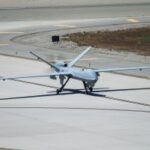Huntington Ingalls Industries (HII) and UK-based defense firm Babcock have announced a strategic partnership aimed at integrating Unmanned Underwater Vehicles (UUVs) into submarine Weapon Handling and Launch Systems (WHLS). Revealed during DSEI 2025 in London, the collaboration marks a significant step toward enabling submarines to deploy autonomous underwater platforms through existing torpedo tube infrastructure.
Strategic Aims of the HII-Babcock Partnership
The core objective of the partnership is to develop an integrated solution that allows UUVs—particularly large-displacement variants—to be launched and recovered via standard submarine torpedo tubes or vertical payload modules. This would enable navies to deploy autonomous capabilities without requiring major structural modifications to existing or future submarine classes.
According to official statements from both companies at DSEI 2025, the cooperation builds on complementary expertise:
- HII Mission Technologies brings experience in UUV design and autonomy software via its REMUS family of vehicles.
- Babcock contributes deep knowledge of WHLS integration through its work on Royal Navy platforms like the Astute-class submarines.
The joint effort is intended to produce a modular interface that can be retrofitted onto existing submarines while also informing future SSN(X) or SSNR designs. The partners are reportedly focusing on NATO-standard 533 mm torpedo tubes as the primary deployment mechanism for medium-to-large UUVs.
Technical Challenges in Submarine-Launched UUV Integration
Deploying UUVs from submerged submarines presents several engineering hurdles. Traditional torpedo tubes are optimized for rigid-body weapons like heavyweight torpedoes or cruise missiles. In contrast, many large-diameter UUVs have different mass distributions, propulsion needs, and launch dynamics.
Key technical challenges include:
- Launch sequencing: Ensuring safe ejection without damaging sensitive sensors or propulsion units on the UUV.
- Buoyancy control: Managing trim and ballast changes when launching non-weapon payloads.
- Tethered vs untethered deployment: Some mission profiles may require data links or recovery lines that complicate launch procedures.
- Crew interface: Integrating command-and-control interfaces for autonomous vehicles into existing combat management systems (CMS).
Babcock’s experience in WHLS design will be critical in adapting mechanical interfaces such as cradles, rails, and ejection mechanisms. Meanwhile, HII is expected to tailor its REMUS vehicle architecture—particularly the larger REMUS 6000—for compatibility with submarine deployment envelopes.
Evolving Role of UUVs in Undersea Warfare
The integration effort reflects a broader trend toward multi-domain undersea operations where unmanned platforms augment manned submarines. Large Displacement Unmanned Underwater Vehicles (LDUUVs) are increasingly viewed as force multipliers capable of conducting ISR (Intelligence Surveillance Reconnaissance), mine countermeasures (MCM), seabed mapping, electronic warfare (EW), or even decoy operations.
NAVSEA’s Snakehead LDUUV program—designed for launch from Virginia-class Block V submarines—is one example of this evolution. However, delays and funding constraints have hampered its progress. The HII-Babcock initiative may offer an alternative path by leveraging commercial-off-the-shelf (COTS) technologies adapted for military use.
This approach aligns with NATO’s push for modularity and interoperability across allied fleets. If successful, it could allow multiple navies—including those operating Astute-class or Virginia-class equivalents—to field similar capabilities without bespoke vehicle designs per platform class.
DSEI 2025 Reveal: Industry Signaling Future Capabilities
The announcement at DSEI underscores how defense primes are increasingly using trade shows not just for marketing but also as venues for capability signaling toward government stakeholders. Both firms emphasized their readiness to begin prototype development within FY2026 if customer interest materializes—particularly from the US Navy or UK Royal Navy under their respective SSN(X)/SSNR programs.
No formal contracts have been signed yet; however, both companies confirmed that preliminary feasibility studies are underway. These include hydrodynamic modeling of launch sequences, pressure tolerance testing for vehicle hulls inside torpedo tubes, and CMS integration simulations using digital twins provided by Babcock’s iSupport360 platform.
Operational Implications for NATO Navies
If matured into deployable capability within this decade, submarine-launched UUV integration would significantly enhance operational flexibility across multiple mission sets:
- MCM Operations: Deploying expendable or recoverable drones ahead of manned vessels reduces risk exposure in mined waters such as chokepoints or littorals.
- Tactical ISR: Covertly deploying sensors near adversary coastlines without surfacing enhances situational awareness while preserving stealth posture.
- Saturation Tactics: Coordinated operations between manned subs and multiple autonomous drones could overwhelm enemy ASW assets via distributed acoustic signatures.
This capability would also support emerging concepts like Distributed Maritime Operations (DMO) by allowing undersea nodes to operate semi-independently while relaying data back via acoustic modems or satellite uplinks upon surfacing. Crucially, it would allow legacy boats nearing midlife upgrades—like early-block Virginia-classes—to gain new relevance through software-defined payload flexibility rather than hardware overhauls alone.
Conclusion: Toward Modular Undersea Autonomy
The HII-Babcock partnership represents more than just industrial collaboration—it signals a doctrinal shift toward modularity in undersea warfare architectures. By enabling existing platforms to act as motherships for autonomous assets without compromising stealth or survivability metrics, NATO navies can accelerate capability insertion timelines while controlling costs.
If successful prototypes emerge by late this decade—as indicated by both firms’ timelines—the program could influence procurement strategies not only for next-gen nuclear attack submarines but also allied conventional fleets looking to extend utility through hybrid manned-unmanned concepts. As undersea competition intensifies globally—from Arctic routes to Indo-Pacific chokepoints—the ability to flexibly project autonomous effects from stealthy platforms may prove decisive in future maritime conflicts.









